Everest Base Camp Trek in Winter...A Good Idea or Plain Stupid?!
Being a touring musician can often mean you have to make sacrifices. Nights out with friends and family gatherings are often missed, as is as a holiday. As one year rolled to a close I realised I was going to have 16 commitment free days. I went on line and spotted Intrepid were offering a discounted trek to Everest Base Camp.
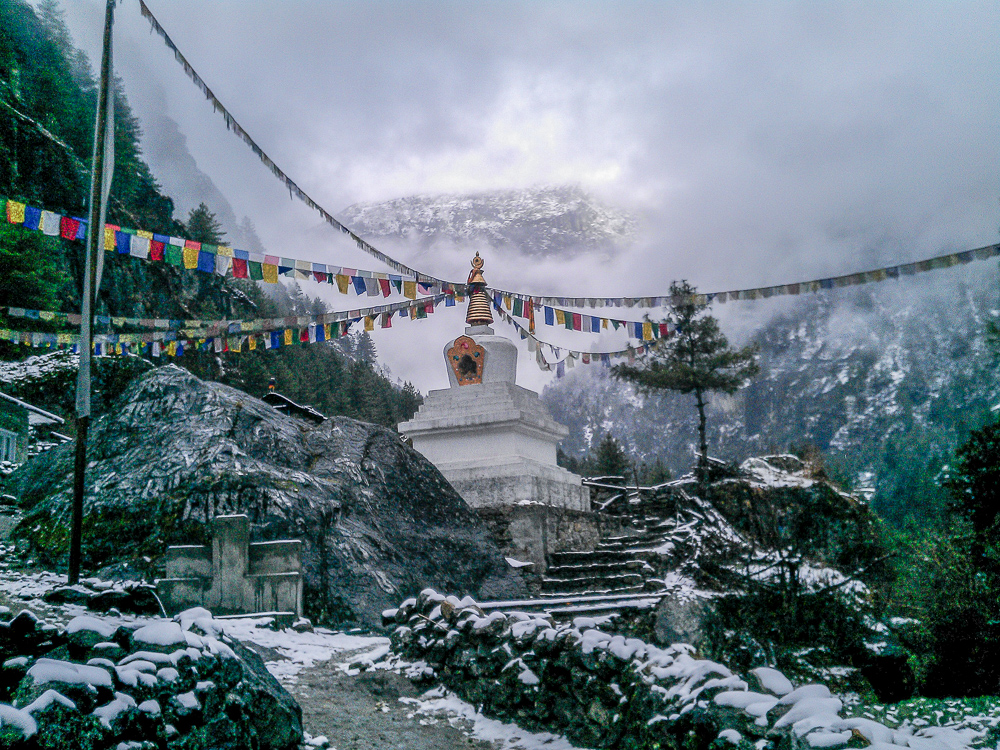
I knew nothing about it. I imagined it was a hard trek. I also wondered why if you were going all that way to Base Camp why you wouldn’t climb to the top (naivety is wonderful). One thing I was sure of; it was going to be cold. Very cold. It was the middle of winter after all.
I checked for flights to Kathmandu, but they were expensive. Although I thought the trek would have been fun, I didn’t want to re-mortgage the house for a flight. So off I went to bed and figured I’d spend my time at the end of the year relaxing instead.
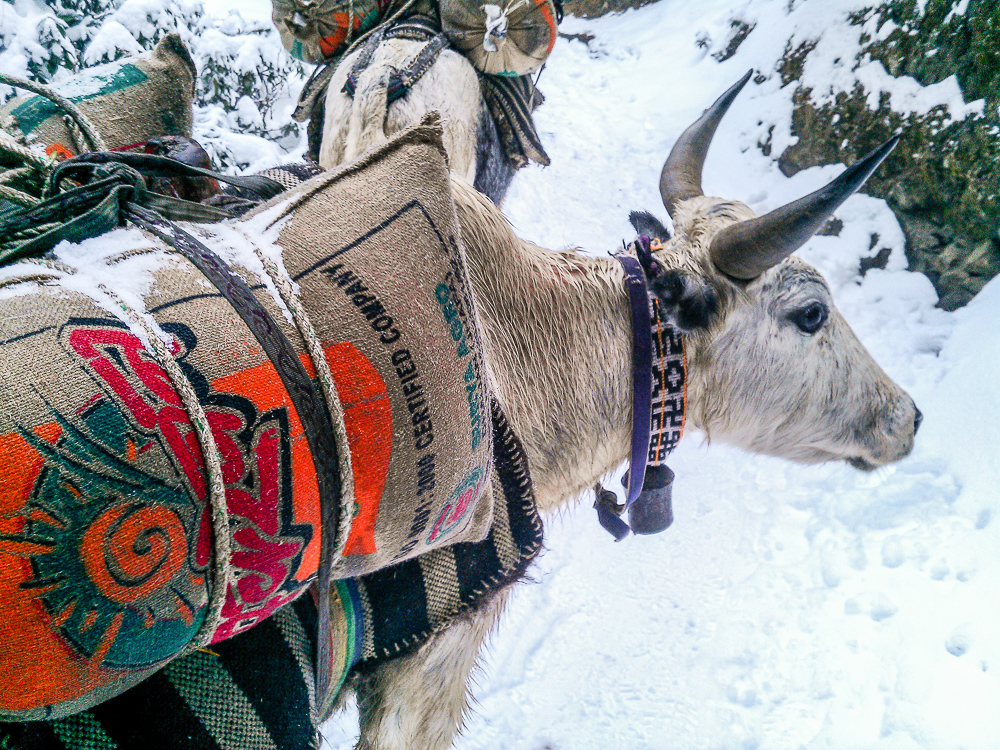
Having itchy fingers, I decided to have one more look the following day. The flight price had dropped. In fact it had almost halved. I booked it there and then. A quick phone call to Intrepid and I was shortly going to leave for the Himalayas. What joy!
Before departing I did a bit more research on the Everest Base Camp trek. Common search results showed ‘potential death from altitude sickness’, ‘give yourself months to prepare’ and of course, ‘stay hydrated’. Hmmm. I was a frequent gym goer and walked to work, so I was probably going to be fine. “I’m off to trek Everest Base Camp” I told my friends. “Don’t die” was the usual response.
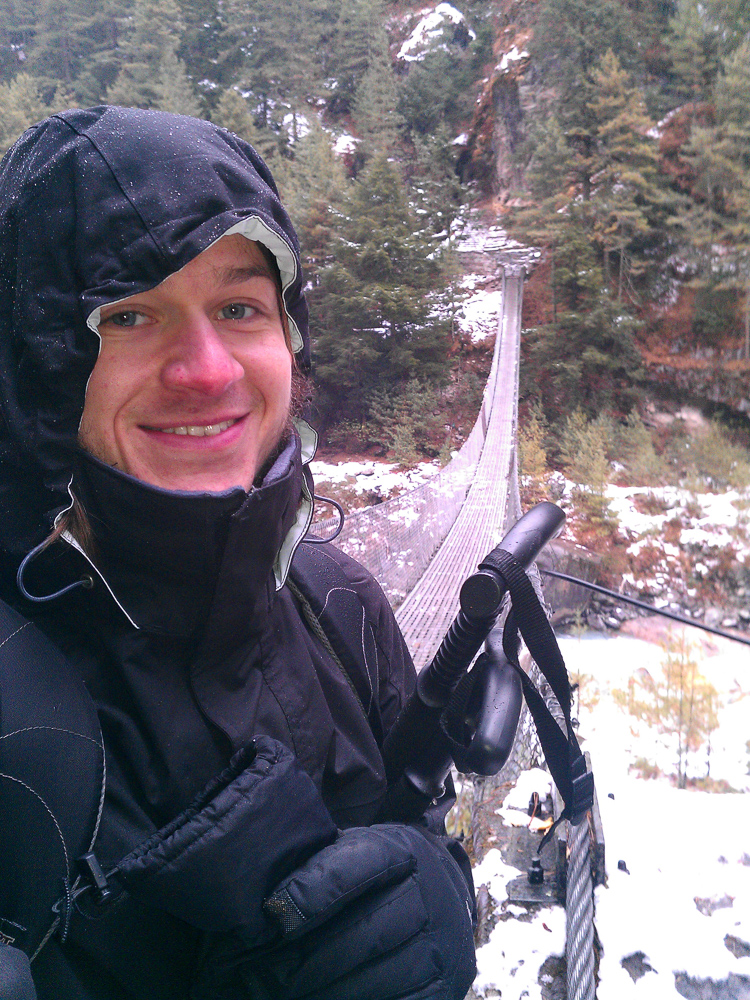
Landing in Kathmandu, I spent some time exploring the city, before attending a pre-trip meeting at the hotel. I sat down and met a school head teacher from Australia and our guide. He started talking and I said “shouldn’t we wait for the others”. “It’s just us” he replied. I should have latched on that most people don’t attempt such a feat in the middle of winter.
Day 1 (altitude 2,610 metres):
It was New Year’s day and we left the hotel at 4AM to catch a flight from Kathmandu to Lukla. We had to wait for Kathmandu airport to open(!) and then I got mistaken for a girl at customs. The airport staff all had a good laugh at my expense. Long hair isn’t too common in Kathmandu.
Tenzing Hillary Airport at Lukla is infamous for being the most dangerous in the world. At 2,860 metres high on a cliff edge, the single runway is a mere 527m in length. At the end of the 527m is a rock face. Crashes are frequent and our guide told us a story about a recent flight which didn’t make it back home. He was on the previous flight and when his wife heard about it on TV, she thought the worst had happened. Oh dear!
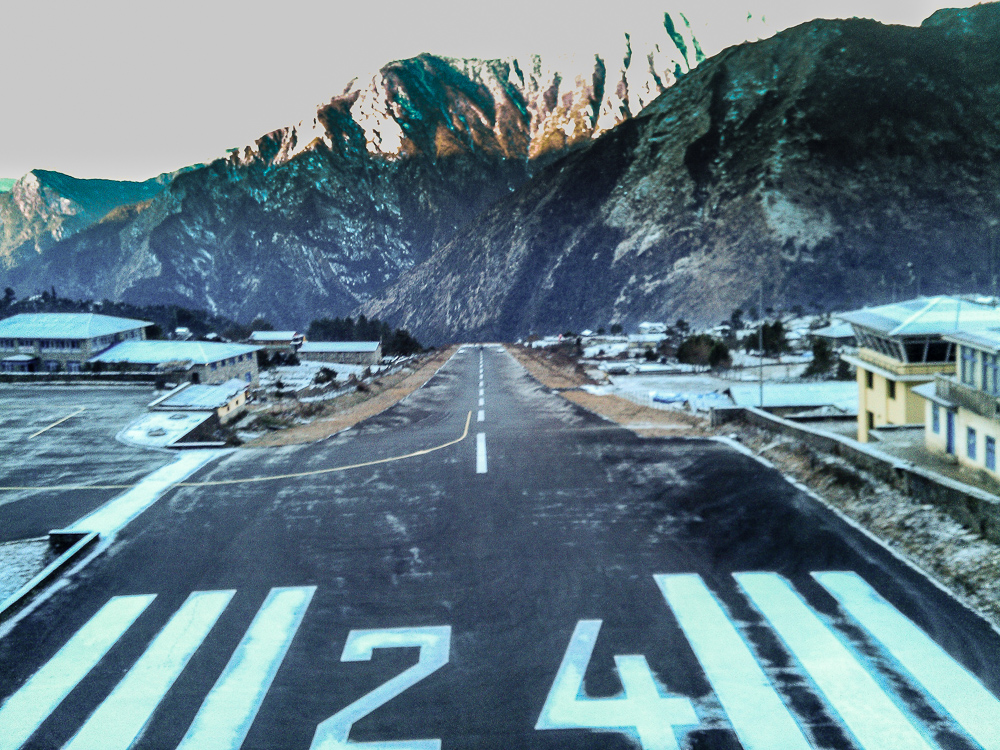
The views were incredible. Flying over Himalayan mountains and into the unknown. The weather can change in seconds and the planes are compact tin cans of no more than 15 people. Thankfully, we landed safely in time for breakfast.
Porters wait around at the airport and grab bags off the plane. It seems to be that they are always waiting for work. If a guide thinks you look strong and healthy, he’ll ask you to come along for the two week trek! Work is tough up here.

Breakfast finished and with glorious weather to greet us, we set off on the trek to Phakding. It was a relatively easy three hours and a great way to break ourselves in. There’s some long suspension bridges to cross and the paths are clear. There’s the last signs of civilisation too, with farmers working the small fields.
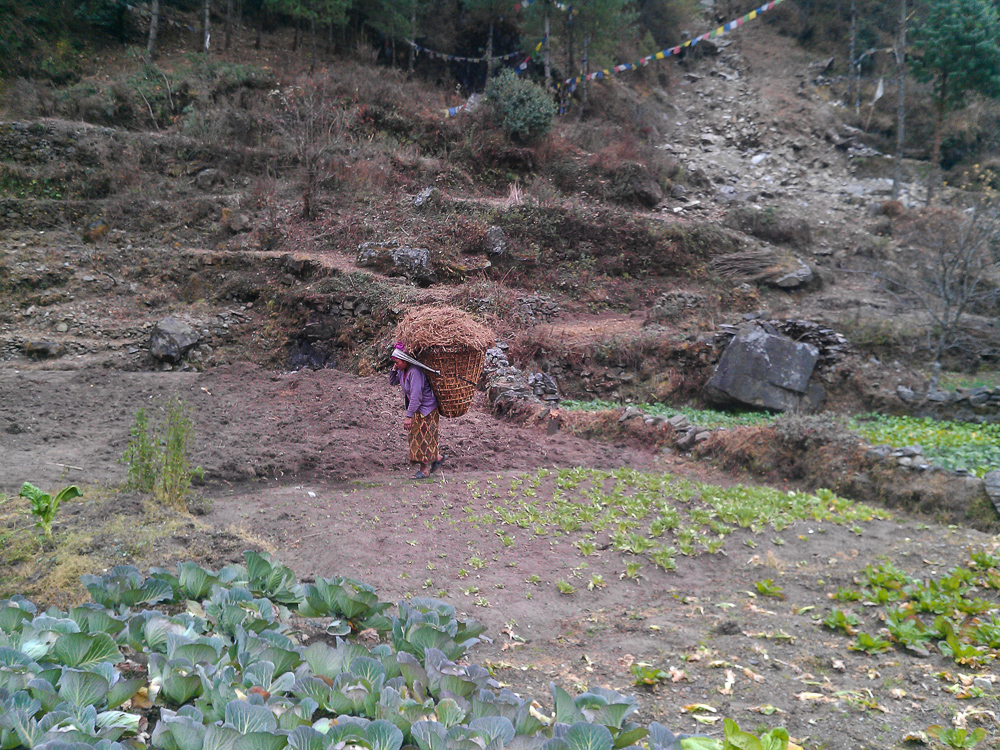
After about an hour my SLR camera broke and told me that it was suffering from ‘Err 20’. Luckily I had my mobile phone, so an HTC Desire was now going to be my camera throughout the trek. (The pictures you see in this post are all from that phone. I’ve done little or no editing and kept them in the raw. I felt it better showcases the harsh environment that was to come in the days ahead).
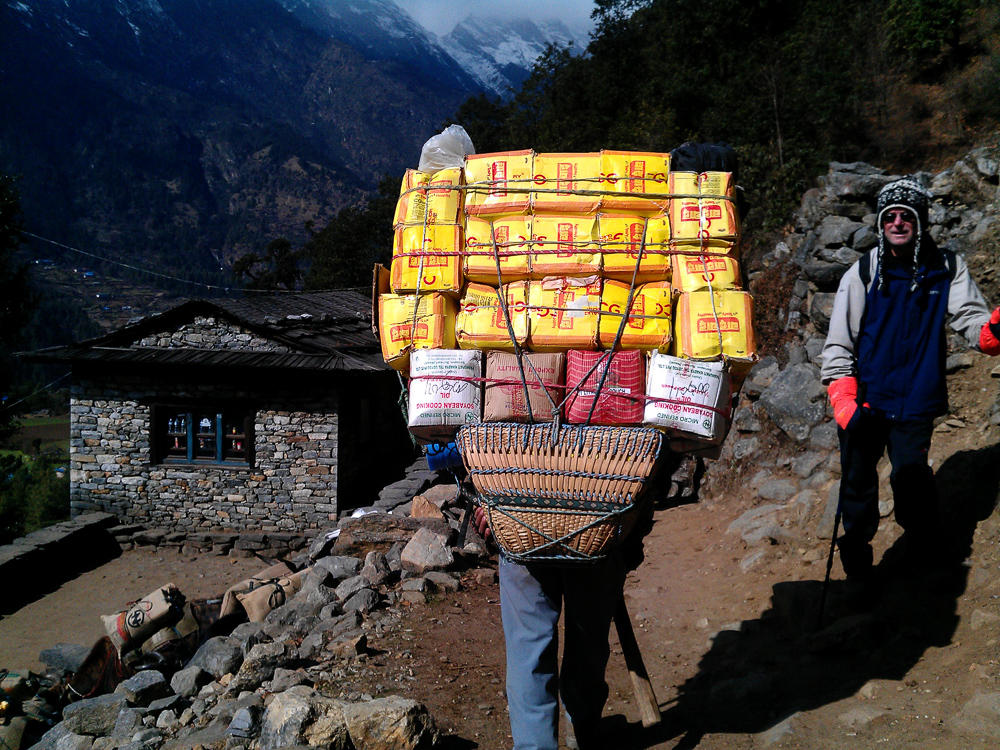
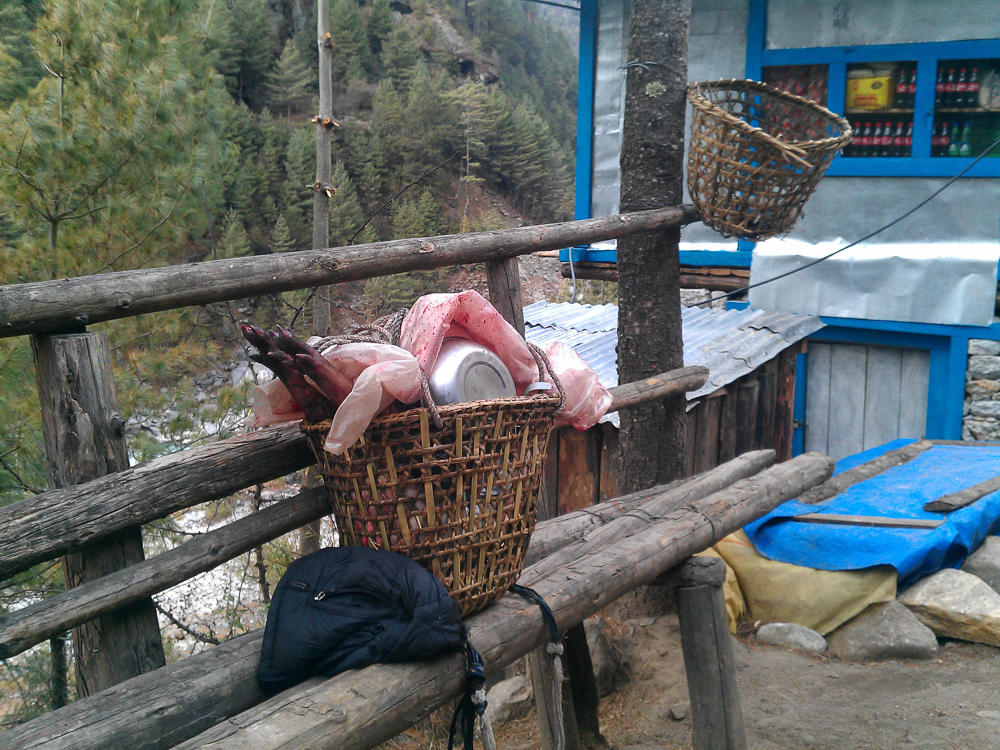
By mid afternoon we had arrived at our accommodation; a small tea house called ‘Snow Lodge’. It was here we met weary travellers who had completed the trek and were on their way back to Lukla.
We exchanged stories over a plate of spaghetti and I started to nod off. The 4AM start and subsequent trek were making me sleepy. I had an early night and slept for 12 hours! Before bed, our guide said he could feel the weather was turning and it might snow for the first time in 10 months.
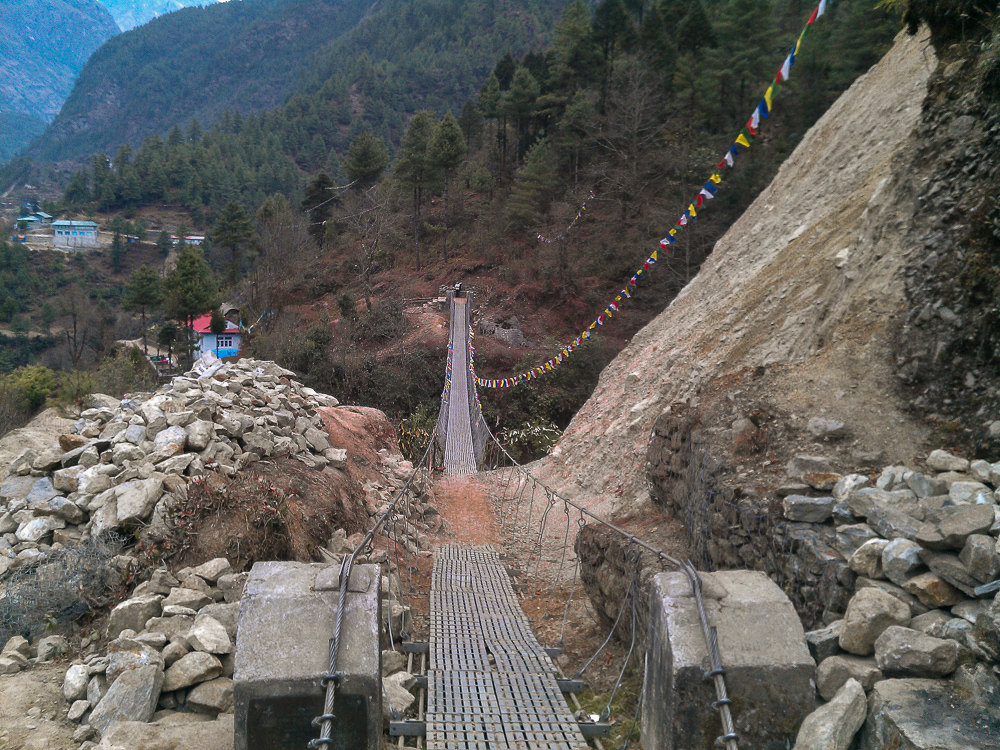
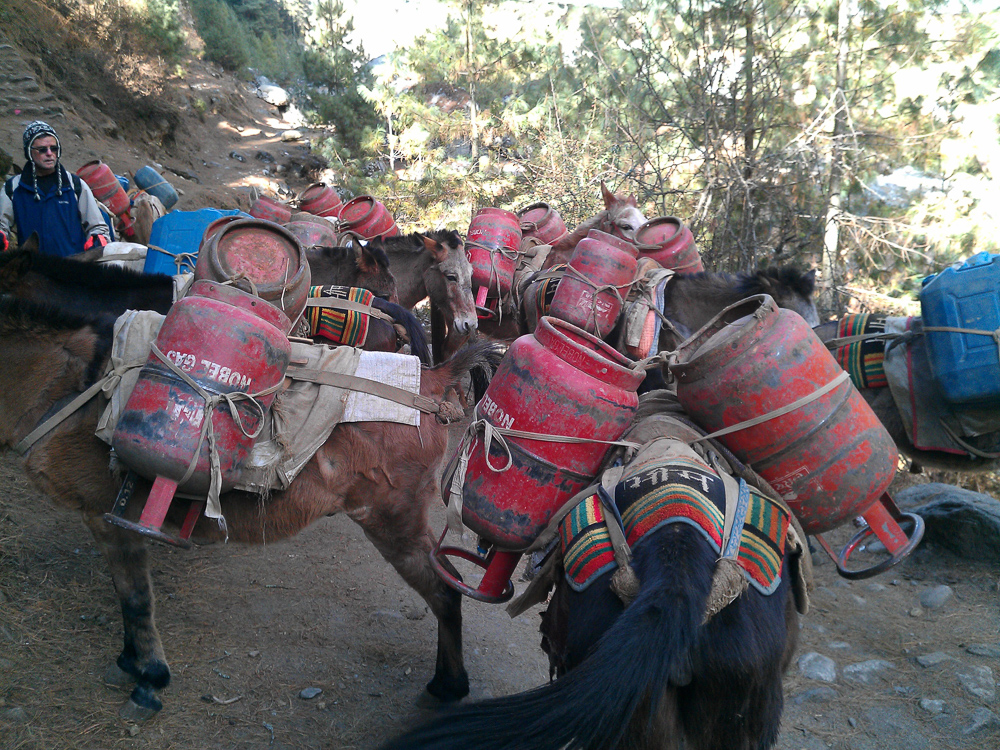
Day 2 (altitude 3,440 metres):
I peered out the thin window of the tea house and it was white outside. This wasn’t the snow we’re used to seeing back home. It had come down and come down hard! The thermals came out as we settled in for what was going to be the most gruelling day of the Everest Base Camp trek. Within no time at all more snow came, followed by rain, followed by snow, followed by rain. You get the idea.

The morning was steady, but the afternoon was hard. It was a six hour ascent up hill! Despite the hardcore climb, the views made it worthwhile. We passed through forests, mountains and rivers. We climbed over boulders and tree routes, all the time thinking about what lay ahead. It was an Indiana Jones experience, as we crossed rickety old bridges adorned with prayer flags flapping in the wind.
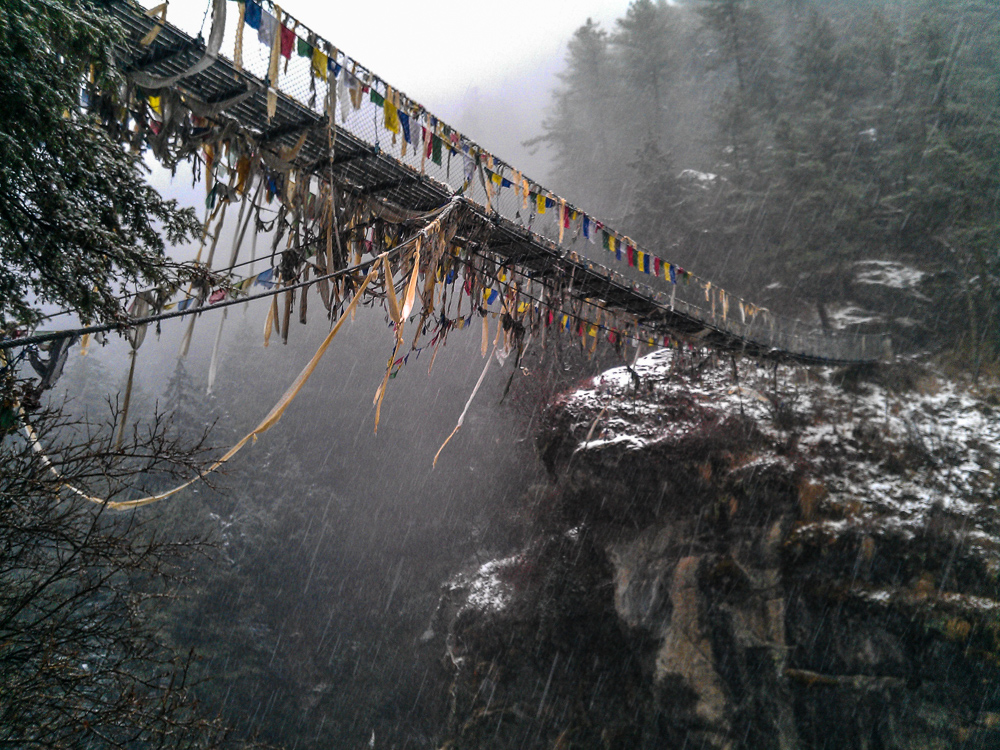
A few hours in to our trek some porters came running past us. They were carrying a girl between their arms. She looked limp and lifeless. Our guide nodded. “Altitude sickness” he said.

By the time we arrived at Namche Bazaar (our destination for the night) I was so drained. I needed to find something fast. I found a small store and within two minutes had shoved a tube of Pringles, Mars Bar and can of Coke inside me. It felt good! Namche Bazaar is an old market town and historical trading point. It’s the last sign of real civilisation before heading deep in to the Himalayas.
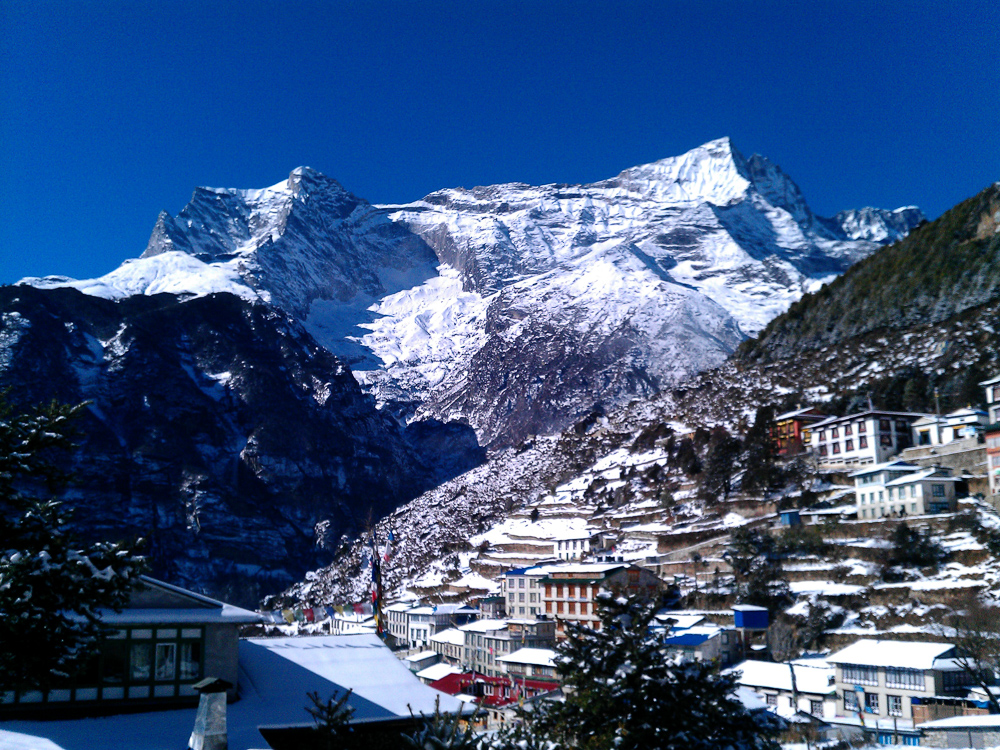
Day 3 (altitude 3,440 metres):
Namche Bazaar is at an altitude of 3,440 meters and a good place to stop and acclimatise. This doesn’t mean sitting around. Rather taking a hike uphill for a few hours and back down again as your body adjusts. A visit to the highest airport on earth and some panoramic views absorbed, it was good to have a break. The weather today had mostly cleared, with only swirling snow mists to contend with. Happy days!
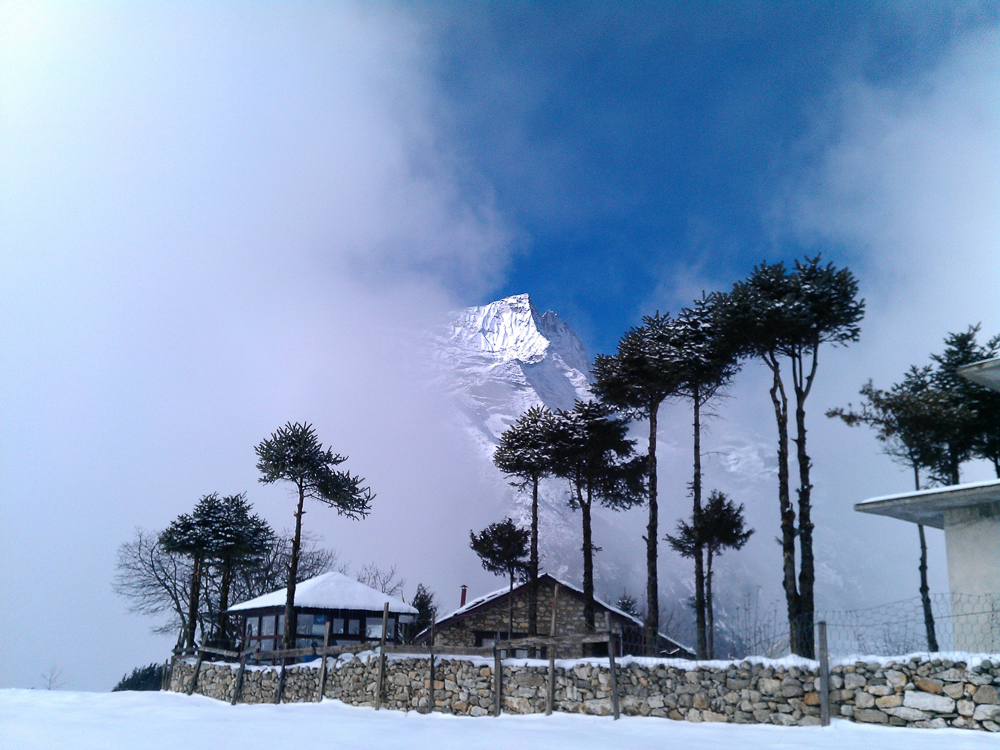
Day 4 (altitude 3,840 metres):
We woke up to beautiful sun and clear skies. It was still cold though! We ascended out of Namche Bazaar for about an hour and twisted around a mountainside. A blind corner didn’t look like it would reveal much, but as we turned, there it was. Mount Everest! The world’s highest mountain in full sight. It’s so high that it looks like it’s in the clouds! (It’s actually snow blowing off the peak, and is impressive).
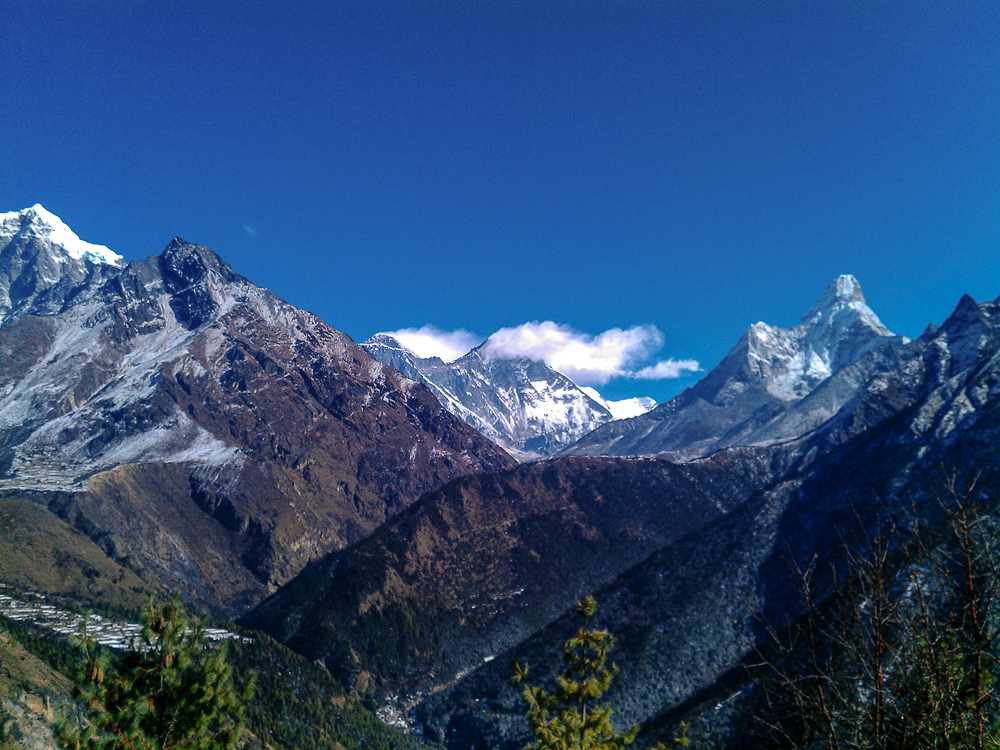
It was such a thrill I could have headed back home, wondering how it could possibly get any better. But there was still another 10 days to go!

Snow kicked in early afternoon and this made the final two hour uphill trek to Tengboche Monastery an enjoyable challenge. Today we walked for a total of nine hours!
Tengboche is the last monastery before reaching Everest Base Camp. It is here that climbers come for blessings before starting their perilous journey. Nearly all the monks had emigrated to Kathmandu for the winter to avoid the biting cold. Although a handful remained and they let us inside to look around.
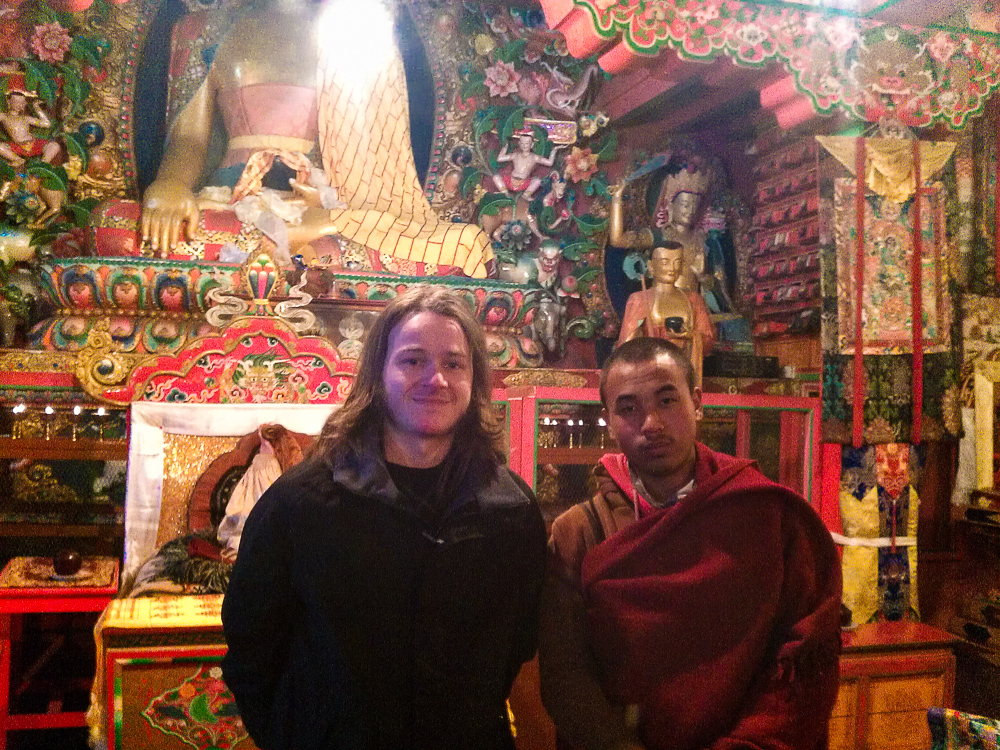
Monks need to be entertainment too. As we decamped to the tea house for Sherpa Stew and a rest, I spotted one out of the window. In full red robes he had homemade skis and was having a jolly old time going up and down the hill outside. Priceless!
Day 5 (altitude 4,410 metres):
As I sat for breakfast the owner of the tea house kept making gestures at me. Not being certain what I had done, our guide translated. He wanted to buy my watch! He was fascinated by it.
This wasn’t a fancy GPS watch. There weren’t even hands. It was a cheap rubber digital which cost me the princely sum of £1 back home. He asked how much I paid and I we managed to translate the exchange rate. He was in awe and wanted to buy it for 130 Nepalese Rupees. I would have felt bad taking his money for something we can get so easily and cheaply back home, so gave it him for free. All I asked for was a photo. He was happy, but never was one to smile!
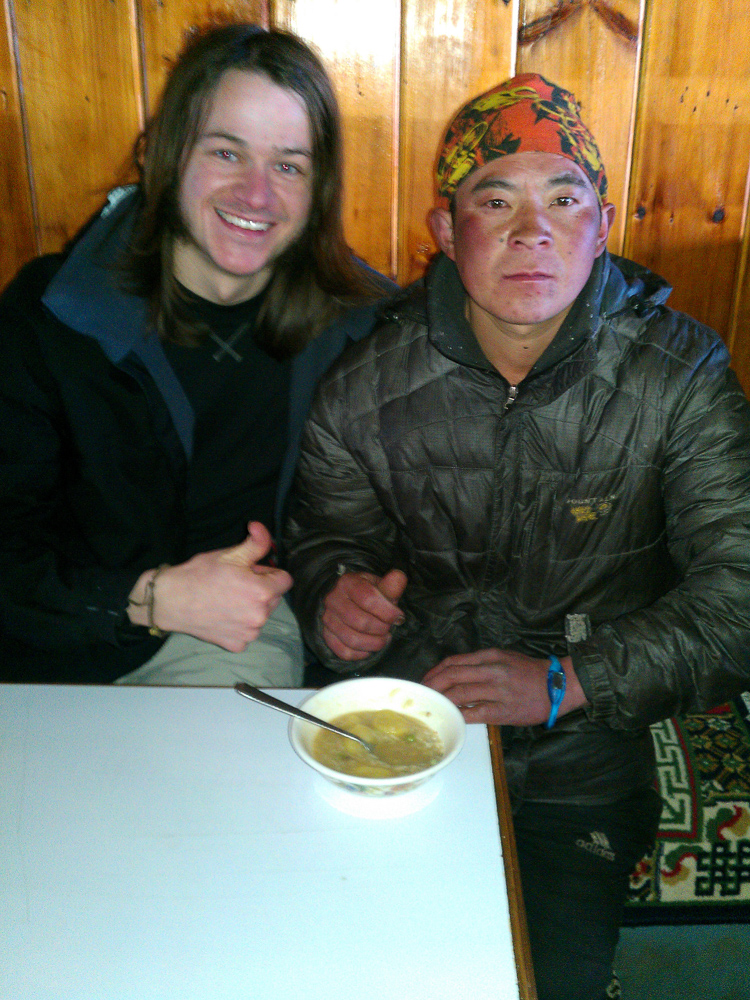
The trek from Tengboche Monastery leads you through a forest and then in to open landscape. We were now above the treeline and in the middle of nowhere. Without a guide and no visible path, I’ve no idea how you’d find your own way in the snow.
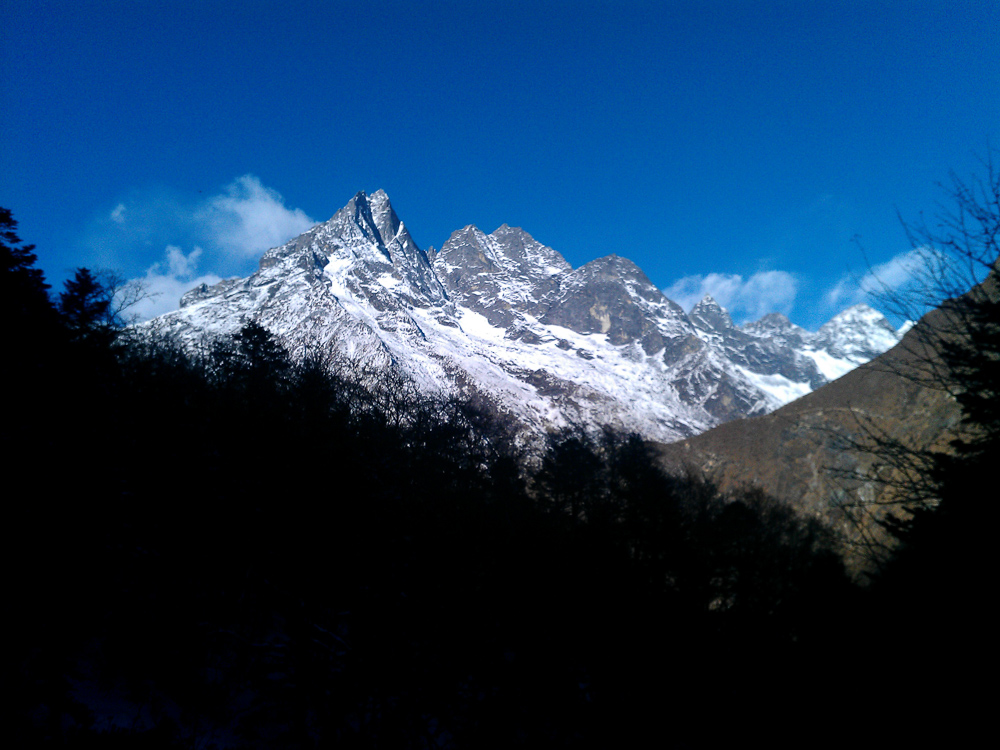
We ended up lodging at the ‘Alpine Resort’ and I tried Sea Buckthorn Juice for the first time. Known for its medicinal properties, the berries grow wild at this altitude. I’m sure they charge a fortune for it in the health food stores back home!
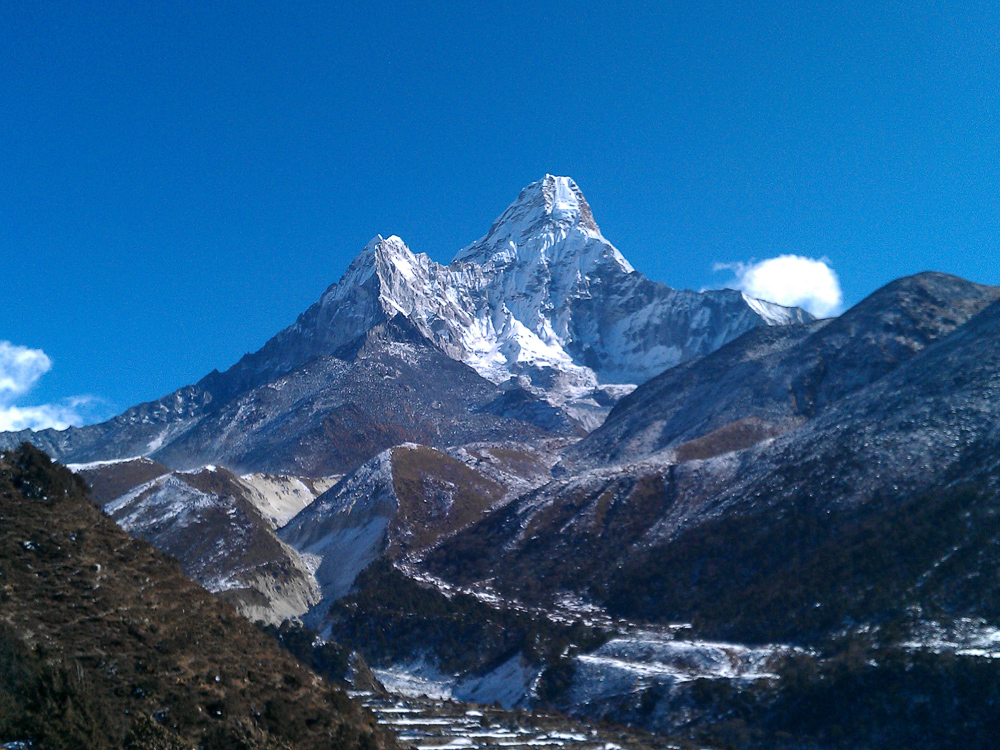
Day 6 (altitude 4,410 metres):
Today was another acclimatisation day. We trekked up Nagarjun Hill to an altitude of 4,800m for a few hours and relaxed at the top. The views were incredible. Mountain peaks and valleys as far as the eye can see. No people, no infrastructure, no technology. All you can hear is the slight gust of wind.
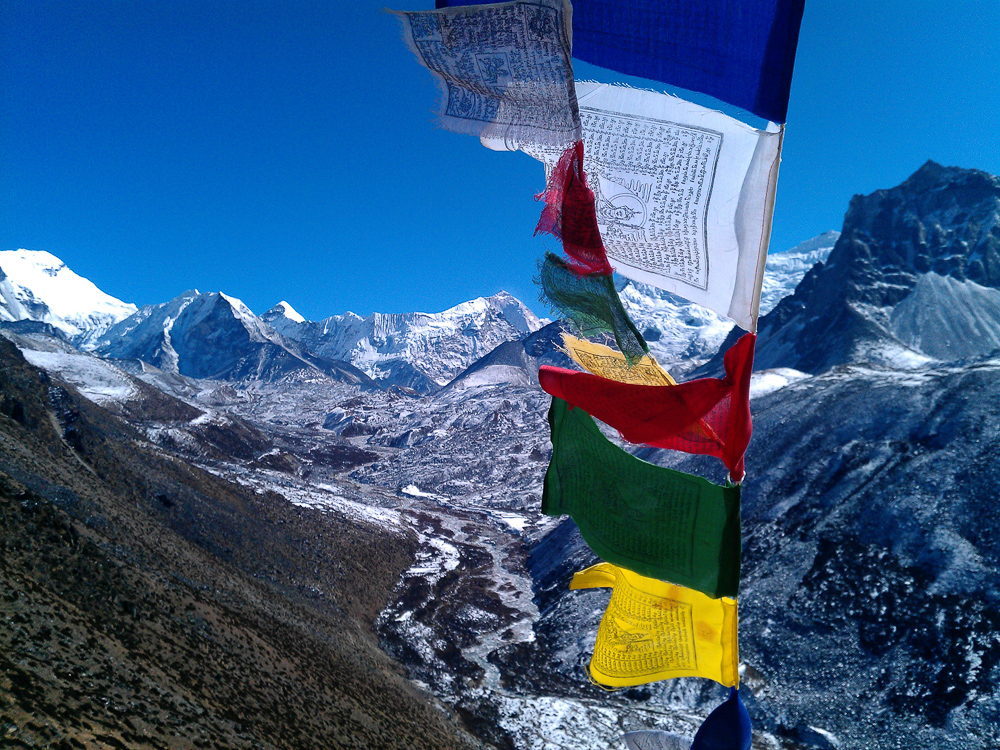
Back at the tea lodge there was time to sit and read and relax. A small child of around two years old played in the corner. A wind up tin bird keeping him entertained. A simple toy and a happy boy. No iPads in sight!
We were now so high that wood for the fire didn’t exist. Trees can’t grow. To keep us warm in the sub zero temperatures, dried yak dung was thrown in to the chiminea. When it had burned out, I made a sudden dash down the corridor and in to bed. The freezing cold biting at any part of unexposed skin.
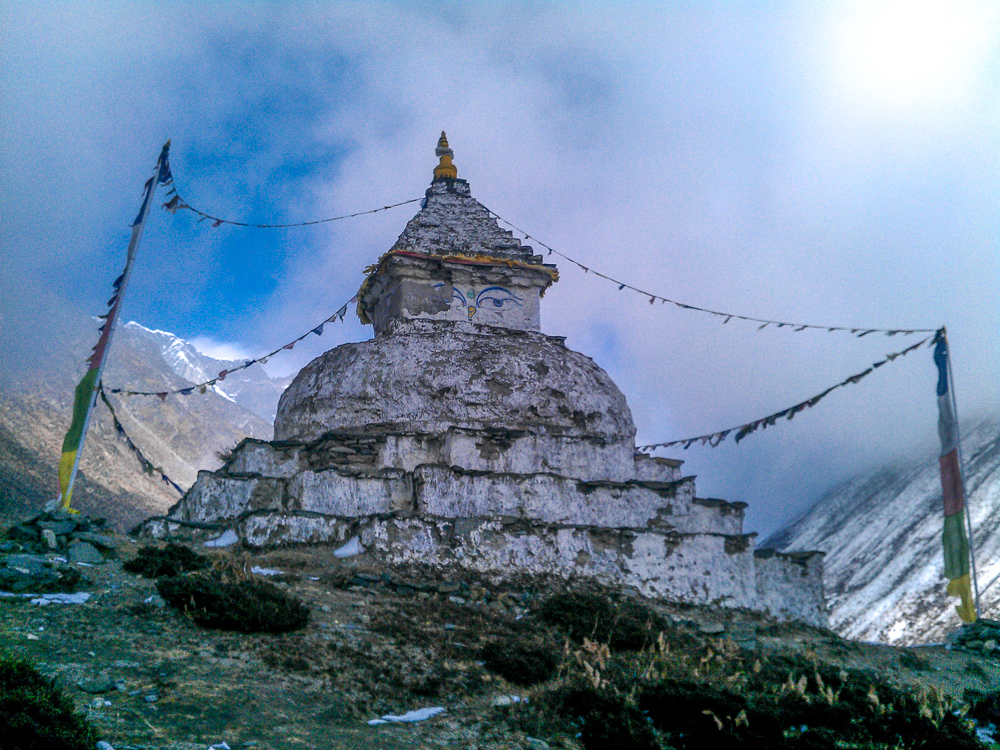
Day 7 (altitude 4,900 metres):
The covers fell off the bed and I awoke in a restless slumber. I generally didn’t suffer from altitude sickness on the Everest Base Camp trek, but think it was starting to get to me a little. In the morning I took some glucose tablets, re-hydration salts and a can of Coke. I was back in business!
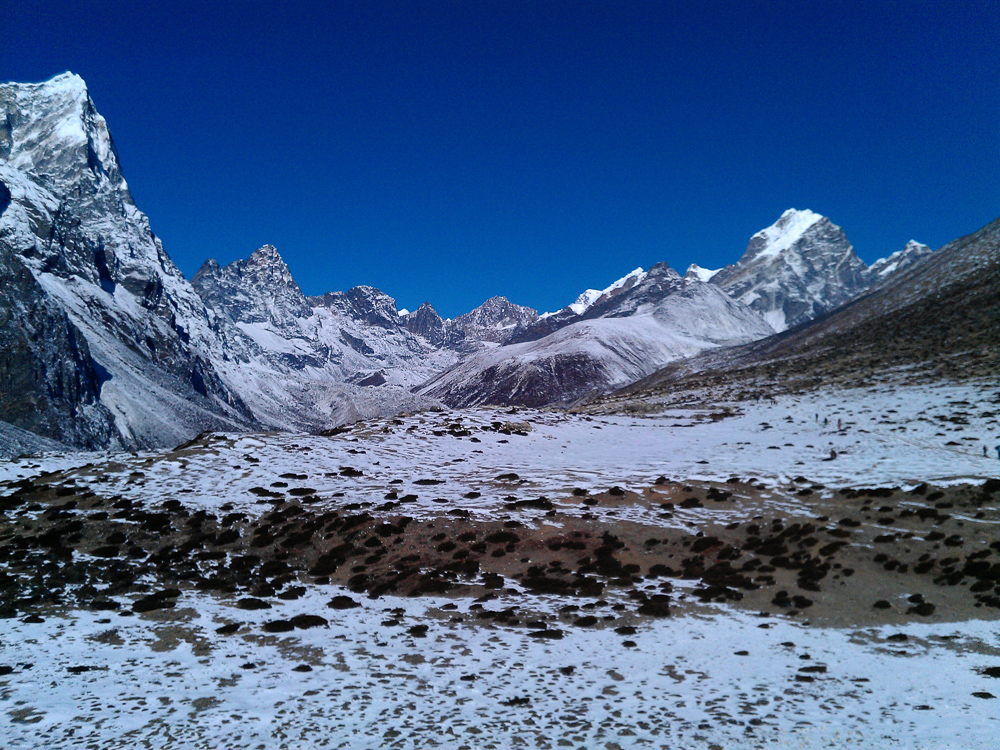
Outside were the most blue skies I had ever seen. Not a cloud. This was a bonus as today we ascending even higher, reaching 4,900m in to the Himalayas. You could sense that Everest Base Camp was near. Tangible excitement filled the air and I knew tomorrow was going to be something special.
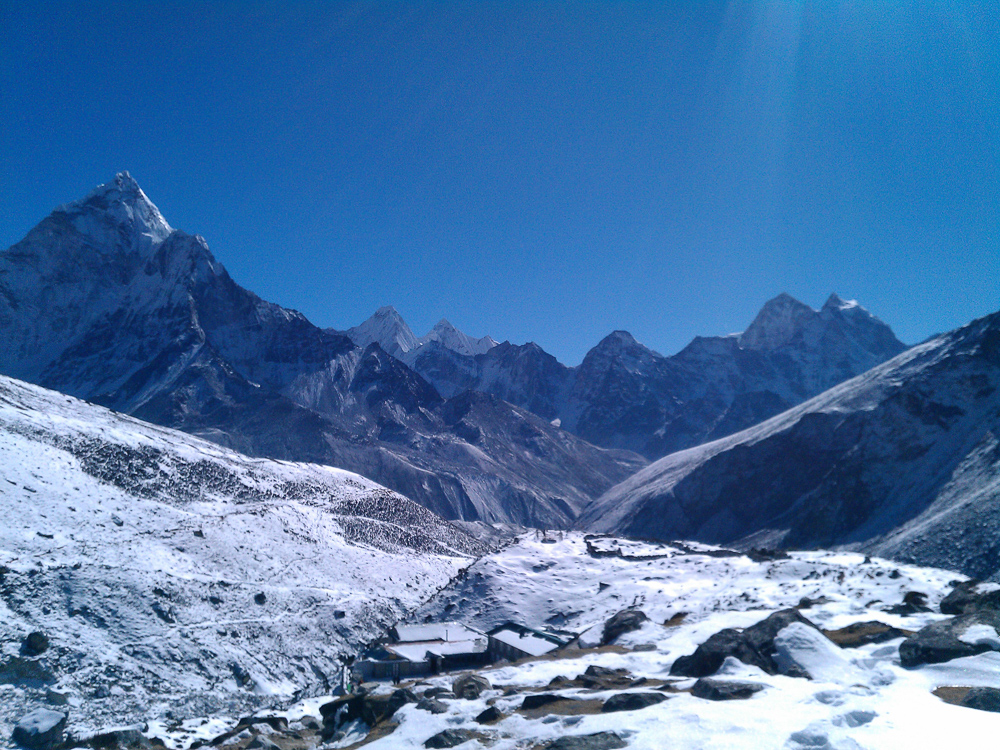
Our guide said that when I woke up tomorrow I should “just go”. He sensed the weather was going to change and change for the worst. Today’s blue skies were going to look very different in the morning.
Day 8 (altitude 5,364 metres):
Rising at 06:00AM it was still dark. It was freezing cold too. Muesli for breakfast and out by 07:00AM, venturing through rain and snow to the first destination of the day; Gorak Shep.
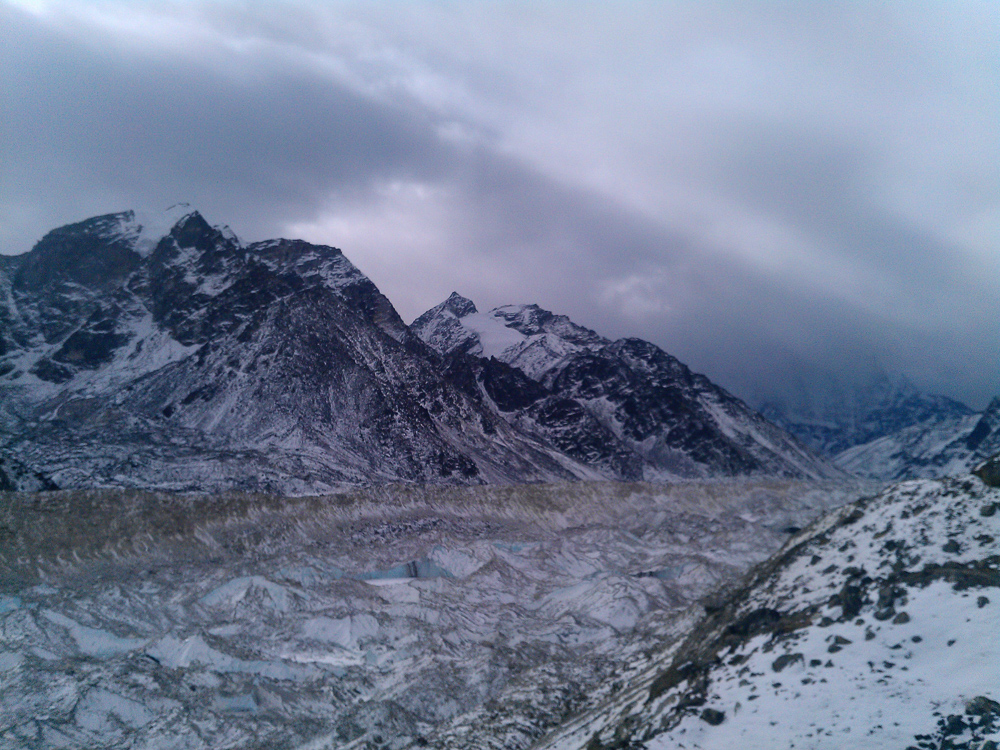
The skies were misty and it was hard to see the peaks of mountains, but we did it in only two hours. This was apparently unheard of, usually taking around four and a half. The determination to get to Everest Base Camp was so strong that there was no time to think about slowing down.
At Gorak Shep we stopped for a snack in the tea house that we would return to later. Replenishing energy for the final push to Everest Base Camp, I ate ‘rara noodles’, drank a hot chocolate and then stuffed a toasted cheese sandwich in my pocket for later. I thought a celebratory drink might be in order when I reached Base Camp, so I put a can of Coke in the other. That’s a real luxury at this altitude!
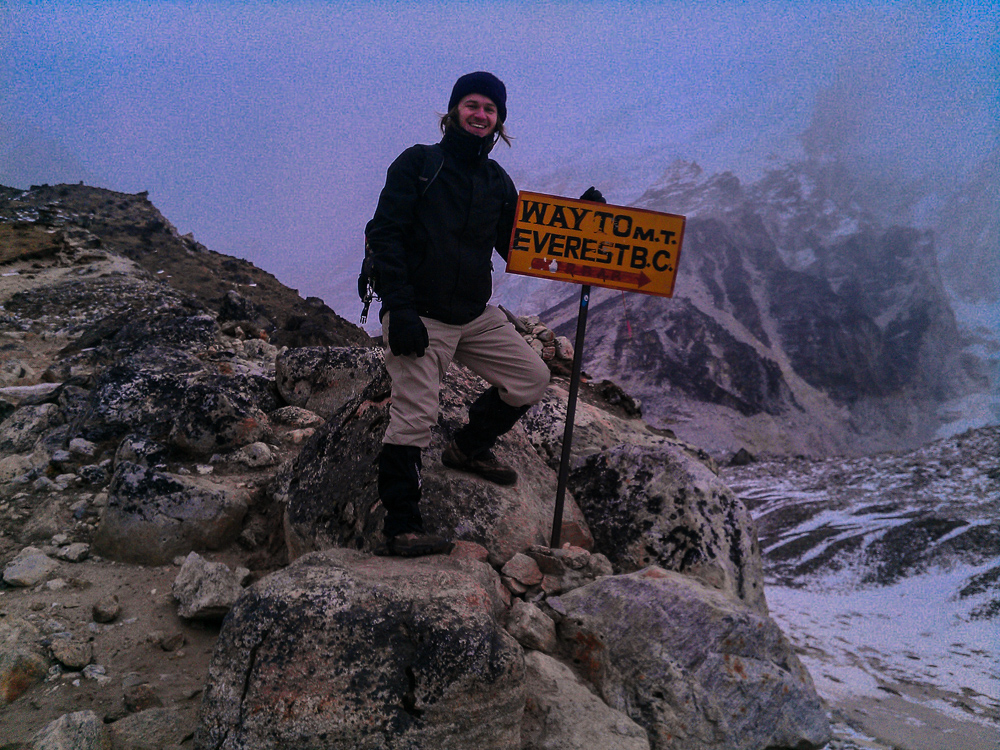
It was now time. Boots tied, multiple layers on, we ventured out into the biting cold. The temperature gauge in the tea house read -25oC (or -13oF). I’ve never experienced anything like it.
The snow was turning into a blizzard. It came at every angle and you had to lean in to the wind in order not to stumble. The ground has turned from snow and stone to slush and ice. Traversing narrow paths with drops either side, we snaked across mountains and past frozen lakes.

Within one and a half hours we arrived. I felt elated. There is nothing of note at Everest Base Camp. Only stones and boulders, one with ‘Everest Base Camp’ scrawled on to it. You can’t even see Mount Everest. It doesn’t matter. The feeling of reaching here after a week long trek in such treacherous conditions was unbelievable.
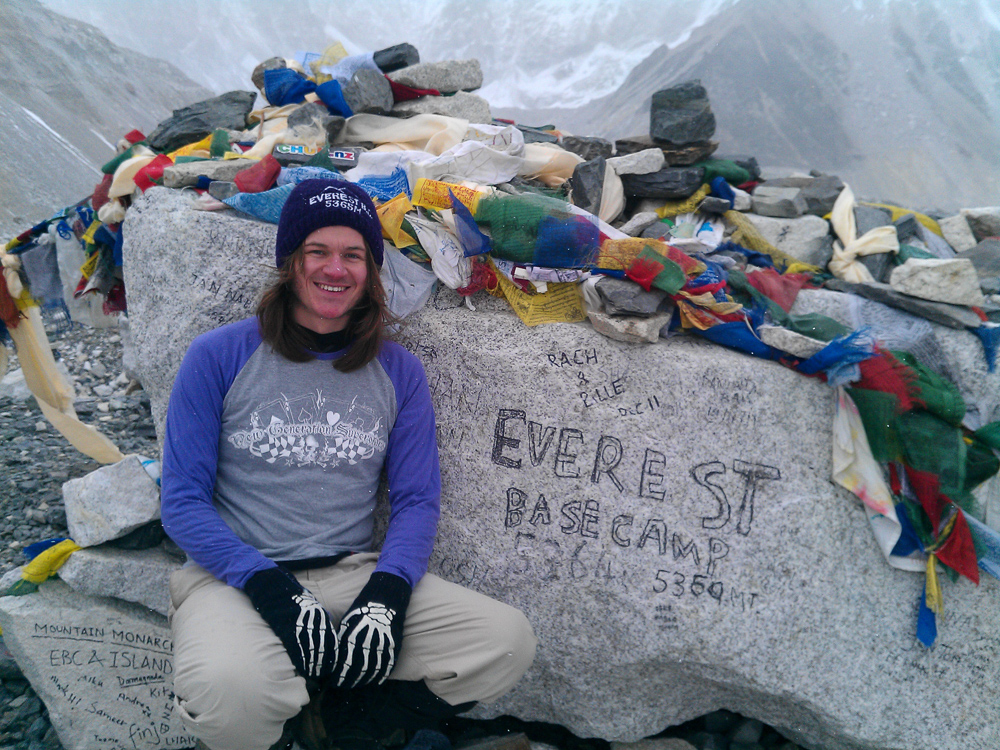
I’ve been told that in the peak trekking season (April – May) there are queues of people of people waiting to reach the ‘Everest Base Camp Stone’. When we arrived there was no-one. Not a single soul in sight. We could well have been some of the highest people in the world at that point! What an experience.
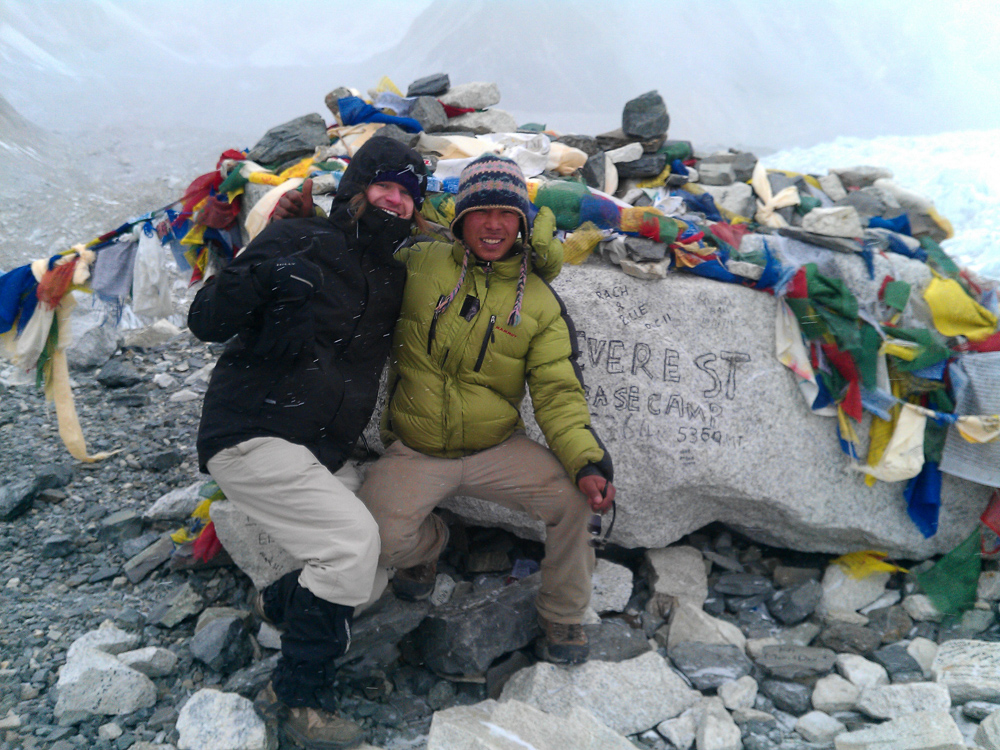
I pulled out my can of Coke for some celebratory energy. It had frozen. I had trekked for an hour and within that time developed a block of iced sugary vegetable extract in my pocket. These conditions weren’t for normal human beings.
As soon as we’d arrived, within a few minutes it was time to turn back. The weather was bad and it was now dangerous to be outside. Photo opportunities made, we headed back to Gorak Shep. Arriving at 13:00, we had spent a total of five hours walking already.
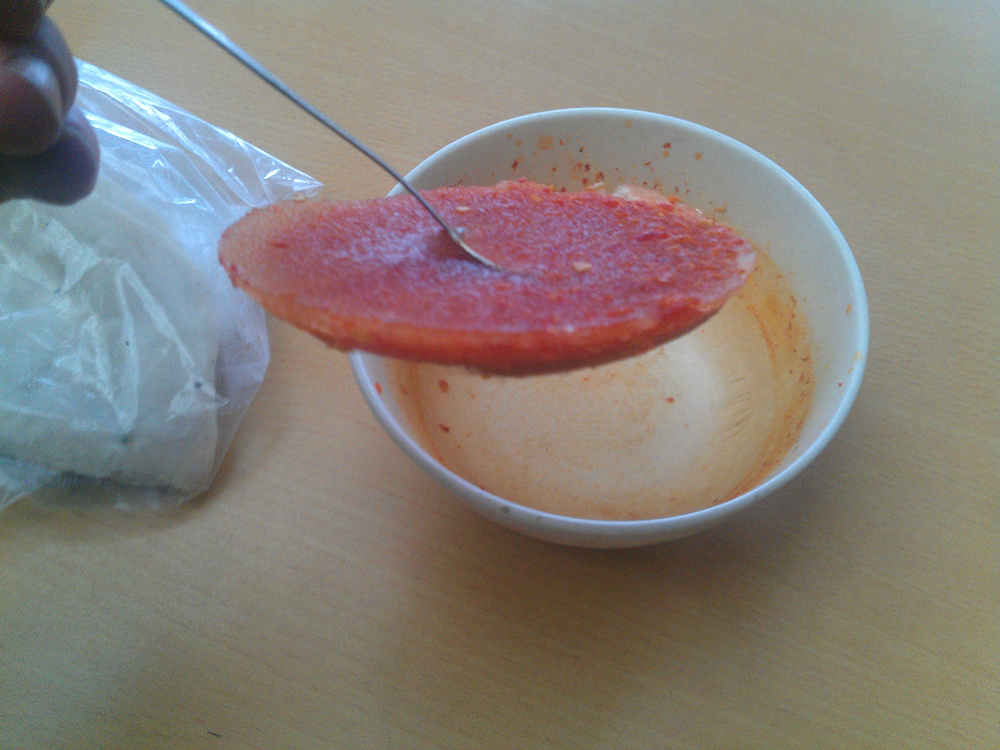
Back at the tea house, the condiments on the table had long since frozen. Lifting the spoon also lifted the pickled chilli sauce out the bowel. And this was was indoors. There’s no other option, but we were technically lodging in a freezer! The adrenaline was so high, that the cold didn’t seem to matter.
Day 9 (altitude 5,585 metres):
To get the best views of Mount Everest, trekkers ascend the mountain peak of Kala Pattar. At any other time this is what we would have done on the morning of day nine.
Our guide said the weather wasn’t going to improve and it might be best to stay in bed and have a lie in. It was up to me though. If I wanted to try and see Mount Everest from the peak of Kala Pattar I would need to be up at 05:00AM. By 07:00AM the weather would likely be so bad that it may be hard to see more than 10 feet ahead.
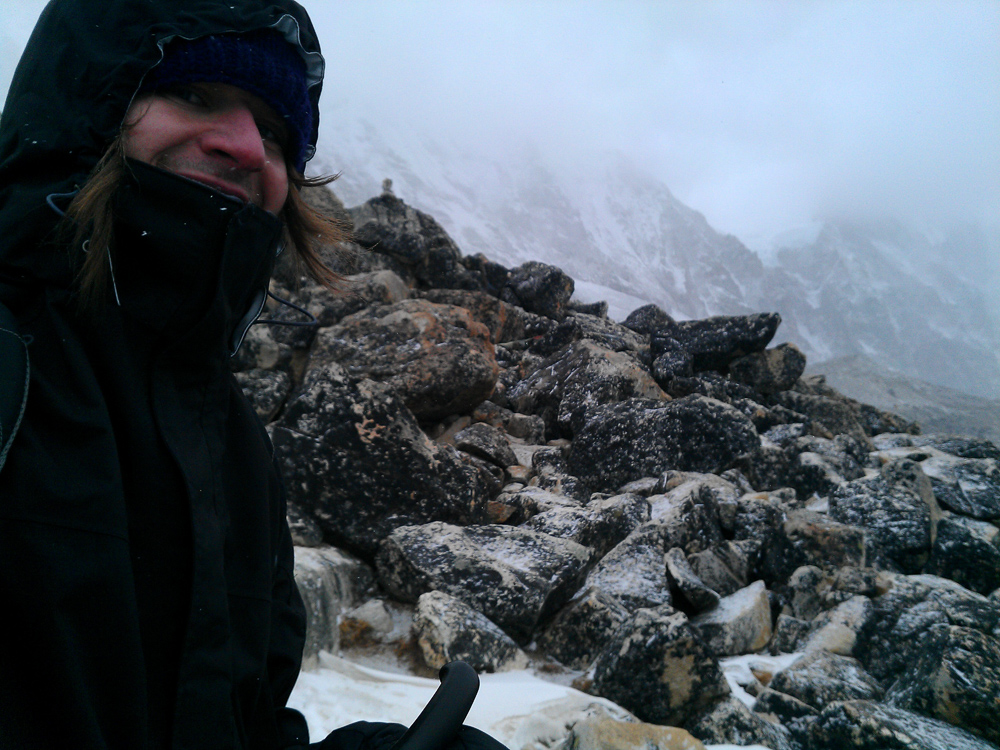
It was likely that I’d only be there once, so I set the alarm. Out of bed at 05:00AM I put on as many layers as I could. With a head torch and sense of adventure, the porter and I tried to ascend the 400m up the mountain. The wind howled. The snow was relentless. Our footing was shaky on the loose icy rocks.
As the sun rose I tried to get a picture of Mount Everest. It was hard to see anything, but we had tried and I’m glad we did.

The rest of the day was spent returning on the path which we came. It’s not advisable to stay at that altitude for long, so we descending down the mountains to Pheriche. At the tea house I met a Korean pop star and a Korean champion wrestler. You never know who you might meet up a mountain!
Day 10 (altitude 3,840 metres):
Going down can be quicker than going up, but steep ascents can hit your knees hard! Today was one of the longest of the trek and we walked for 12 hours! Past Tengboche monastery (where the tea house owner was still happily wearing my watch) and back to Namche Bazaar.
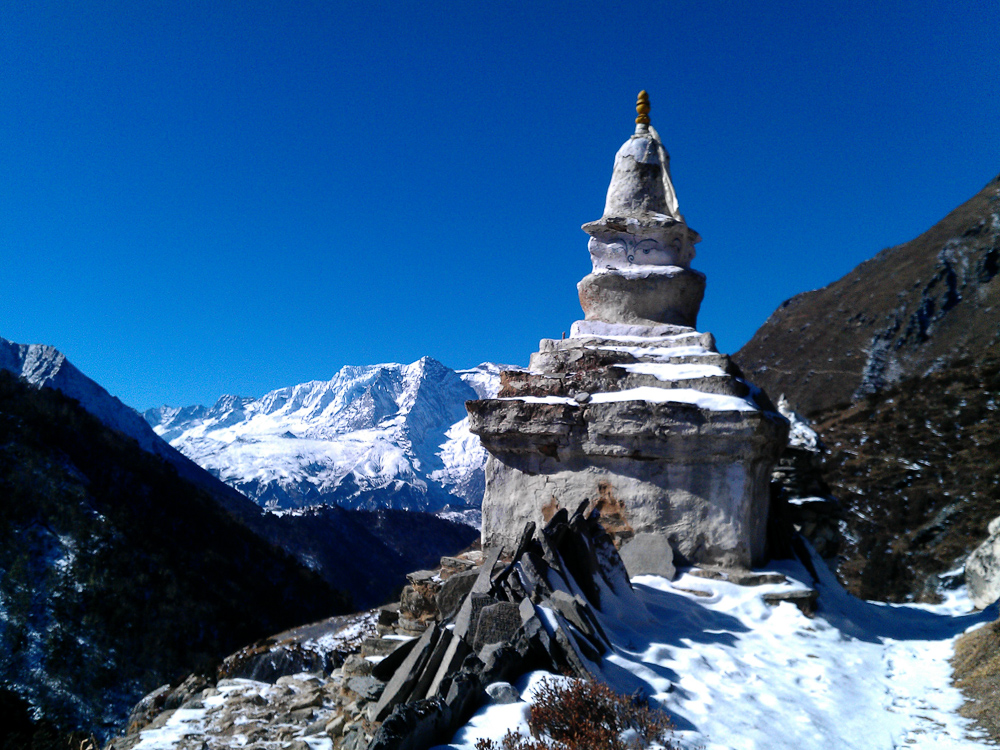
Weary and tired we met some fresh faces who were only a couple of days in to their journey. They were the first ‘travellers’ we had seen for days.
Day 11 (altitude 2,860 metres):
The previous day had been one of the longest of the trek so today felt like light relief. The sun was shining, the skies were clear and we cherished our final view of Mount Everest. Passing back through the forests we trekked nine days before, the steep descent was tiring, but manageable.
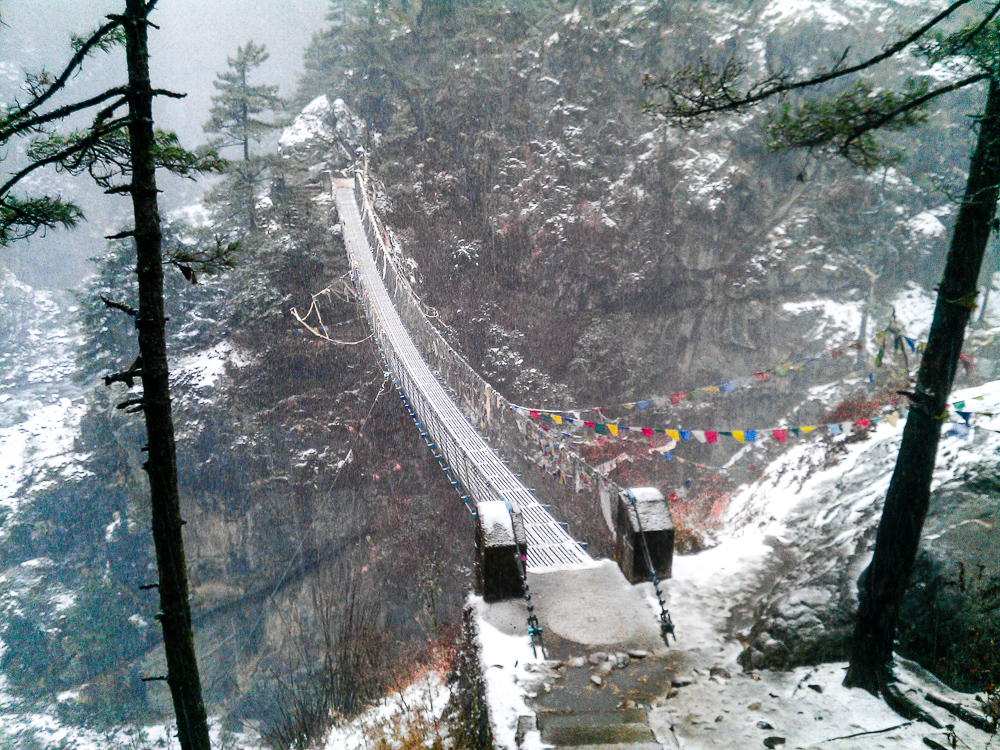
There had been no alcohol on the ascent and I didn’t want it anyway. Now we were officially on the final stretch our guide introduced me to Tongba. An alcoholic drink made from millet seeds. Presented in a tanker, hot water is poured on to the seeds and left for a few minutes. The more you add and the longer you leave it, the stronger the alcohol gets. When it reaches a desired strength and flavour you suck it up through a straw and start the process again.
I knocked a few back at the teahouse that night. Electricity was available and the entertainment was the movie ‘Into Thin Air’. A movie/documentary about an unsuccessful ascent of Mount Everest. There were numerous deaths! Our guide said it was fine to watch it now as we were almost home. The trekkers starting their ascent weren’t so sure!

Day 12 (altitude 2,610 metres)
Lukla was just a few hours away. What was in theory, an easy route felt harder than it should have done. We arrived in Lukla by mid afternoon and chilled out. Our flight was (hopefully) leaving tomorrow. With Lukla being the closest thing to a village, we hit the small bar, played some pool and soaked up the last of the Himalayas.
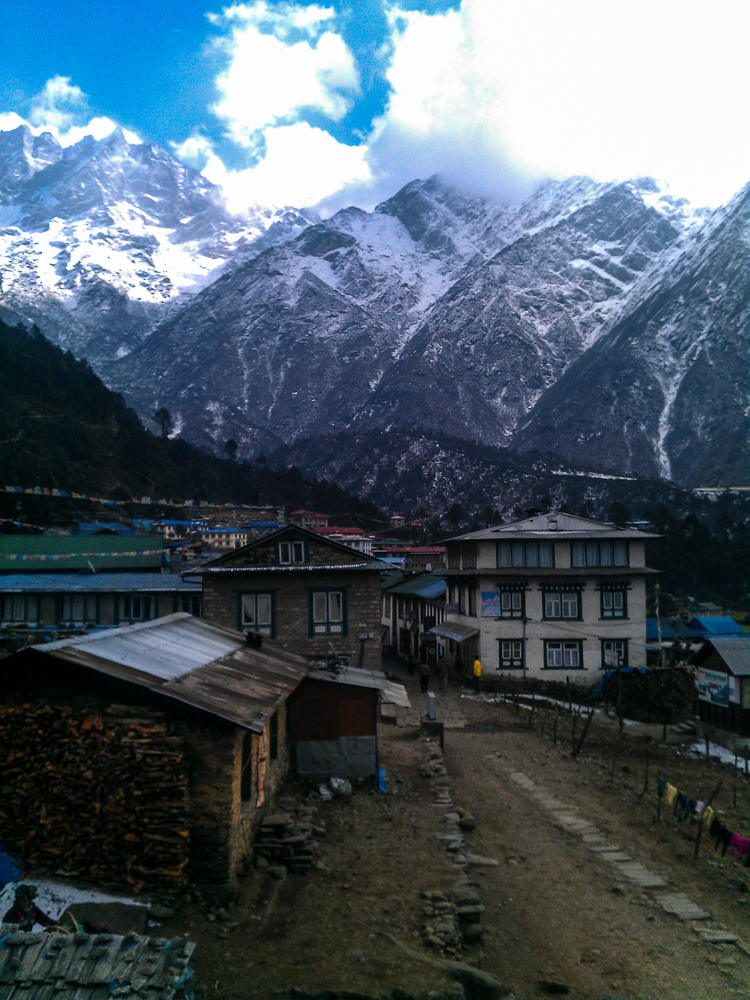
Day 13 (2,610 metres):
I’d heard getting a flight out of Lukla can be hard. If the weather is bad, they don’t leave. If you don’t know a guy who knows a guy, you might not get a place in line. There was a man who’d been waiting at the tiny airport for three days. We didn’t feel confident.
Our guide knew the score though. Chatting to airport staff in his native Nepalese, we were soon ushered through and on to the first flight out (which left two hours late). Flying off the tiny runway was more daunting than flying in. As soon as the plane flys off the cliff edge it dips, before steadily rising through the air.
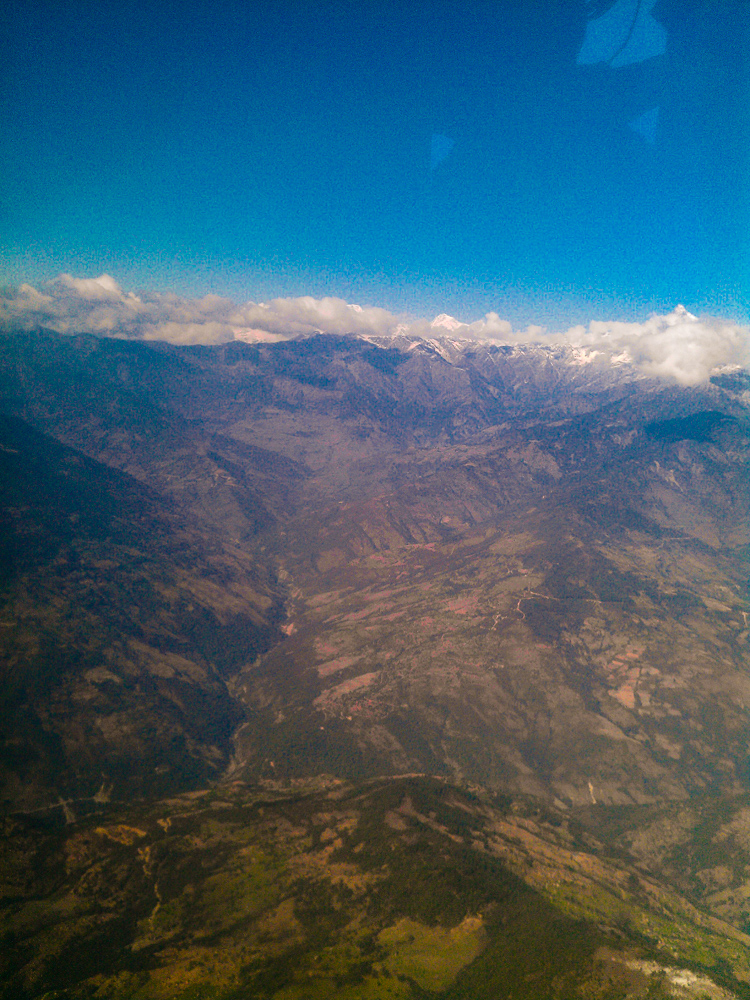
About 20 minutes in, surrounded only by mountains,the plane suddenly dropped. I don’t know how far, or why, but it felt like we were going down. Everyone grabbed on tight. The plane shook and then steadied. The traveller in the seat opposite looked at me. We both smiled knowingly. We’d made it this far and thought we were about to die. If we could only last another twenty minutes on the plane we’d be ok.
We landed in Kathmandu. Everything seemed different. People pottered about their daily business, oblivious to our Everest experience. It was unforgettable. A month earlier I had never even thought of going to Nepal. Now I had trekked in the middle of winter to experience the highest mountain on earth. There could have been no better way to start the year. Almost literally, on top of the world!
How can I do the Everst Base Camp Trek?
You can undertake the trek independently. Unless you’re well experienced, I’d advise an organised tour. These can be arranged at a number of places in Kathmandu or you can book in advance with a grass roots travel company such as Intrepid. That’s what I did and I highly recommend it. They also ensure guides and porters are fairly paid and looked after. If you keep a watch on their web-site you might even pick up a last minute deal.
You will need to book your own flight to Kathmandu. Sky Scanner is a great resource. Remember to search for your flight in an ‘Incognito Browser’ to get the best prices.
How much does the Everest Base Camp Trek cost?
There is no set price, but you need to factor in:
- An international flight to Kathmandu.
- The cost of the trek (this should include your flight to Lukla, all accommodation, plus a porter and guide). It could be anything from £500 – over £2,000. I personally paid a heavily discounted price of £585 and this was an absolute bargain.
- Food on the trek (it depends how many courses you eat, but allow up to £10 per day).
- Tips for your guide and porter. Allow $2-$3 dollars equivalent per day each.
- Gear. You will always need a good pair of hiking boots, but depending on the time of year you may need thermals and a waterproof jacket instead of a down jacket. There’s also a sleeping bag to think about. I looked for some in store sales and managed to kit myself out for less than £100. BARGAIN!
How long does it take to trek to Everest Base Camp?
The Everest Base Camp Trek is 14 days in total. It’s only 38 miles each way, but it takes time due to acclimatisation.
SHARE THIS POST